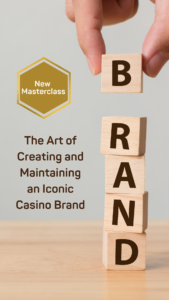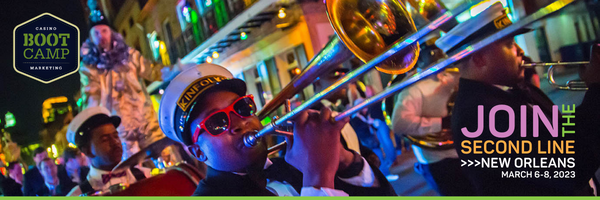The casino industry seems to be shifting every day. We shifted with COVID. We have been shifting for years as managers shuffle in and out and companies buy up assets to expand their size. The pundits will tell you that a recession may be around the corner. That will cause us to shift yet again.
In the case of acquisitions, we have seen a series of rebranding projects. Isle of Capri was acquired by Eldorado Resorts and rebranded as such. Then Eldorado acquired Caesars Entertainment and opted to retain the Caesars’ name at the culmination of the purchase. As Eldorado offloaded a handful of regional properties, Twin River Management snapped up key locations and rebranded them with the classic Bally’s moniker, beginning with Kansas City and on. More recently, the Horseshoe name has found new homes in Lake Charles and the Las Vegas Strip blocks from where the brand originated.
The concept of a brand is often confused with the idea of a logo. Brands are about what the company values and how it does business, but because brands are usually represented by a logo, photos, colors, and typography, the concept of rebranding can lead us to make less-than-perfect decisions.
Branding and rebranding can be risky. It will affect how your team members and customers see you. If done correctly, your company can see the benefit of long-term success. If done poorly, you could end up with nothing but a new logo.
Still, rebranding can aid you in growing your business and reaching new customers. At the very least, it is guaranteed to create news for your brand.
When Rebranding Your Casino, Consider the Heart of the Matter.
Rebranding is costly in both time and resources. Besides the apparent destruction of logo items and the production of replacements, rebranding projects involve research, training, communications, and gut checks at every point. Rebranding should always include an in-depth look at your brand values and purpose. This post is not about logos. It’s about your BRAND — who you are.
For the most part, casino marketers sell the same thing — slots, table games, various food and beverage offerings, hotel rooms, concerts, and promotions. More recently, as states have opened up sports betting and online gaming, we also find ourselves selling more of the same options. So, it is easy to start looking very similar. It is common to find markets with no differentiation between options, and customers will unfailingly begin to choose based on offers and rewards. If you can fail the ad test (putting your hand over the logo to see if you can identify the casino), consider a rebranding. I am not saying you need a new logo. You can begin with a better focus on (and communicate) what makes you distinctive.
If the business strategy has shifted (perhaps to target a new audience or because of changing consumer attitudes), consider a review of your brand strategy, which may lead you to a need to rebrand. Business, brand, and marketing strategies must be interwoven in such a way as to support each other. A brand has to speak to its audience; if your brand and audience are like a couple on the track to divorce, a rebrand may be just what the marriage counselor ordered.
Our offerings have changed with market changes, but we have often rested on the brand’s laurels without breathing life into it. You may be working with a very aged brand that has yet to keep pace with the current desires of casino customers. Additionally, long-term team members may be holding on to old notions, while newer hires see nothing they can work with to create exceptional guest experiences.
A look at historic brands will show that only a handful has been able to hold up to the test of time. Brands such as Carhartt, Yuengling, LL Bean, Whirlpool, Colgate, and John Deere have continued to innovate and provide something “useful” to the consumer. Conversely, the list of defunct brands is eye-opening. Entertainment options do not have the benefit of “usefulness.” So, we must be able to continue to connect our brands to the hearts of our guests.
You might also have modernized your offering to meet the newer market demands, but you are still relying on out-of-date values (and processes). If your values have evolved, you want to evaluate a possible rebranding project to shift your focus to the present rather than the past.
If you saw your brand in any of these situations, you may be a prime candidate for a rebrand.
Risks of Casino Rebranding
The desire for the spotlight can often lead business leaders to undergo a rebranding that can backfire. Whether it is correctly done or merely a logo change, rebranding is a little like turning a ship. It takes time. Failures are unfortunately not too uncommon, though the reasons may be.
-
You are just tired of what you have been communicating and want something new.
-
You have not done enough research into the real issues.
-
You make a change that does not support the business strategy, or perhaps the strategy itself needs to be corrected.
-
The changes are meaningless.
-
You work through the process in a bubble and lack the support of stakeholders.
-
You lose brand equity.
The biggest misstep is the bandaid — when you create something to solve a problem today rather than looking to sustain the brand for some time. You want to build your brand not just for today but for the future as well. You want to consider the various trends impacting the casino industry, the evolution of technology and communications channels, and the evolving customer base. Anticipate how these changes will affect the brand and your operations.
Reasons Not to Rebrand Your Casino
This post focuses on all the problems with rebranding because (as I have said) it is a long and involved process. We always want clients to be fully committed to the process, and bringing up the negatives allows them to consider the traps and limit the surprises they will find along the way. We want to know why you want to do this now, why it was not done earlier and why you cannot wait another year or two.
A discovery process should unearth all of the reasons. If they are any of the following, we assist clients in identifying other ways to right their brands.
-
To shift the focus on internal problems. The inner workings of an organization cannot be corrected or hidden from view through rebranding. This, by far, feels like the most significant stop sign ever.
-
We need something new to generate some good press. You might successfully get some good PR, but it will only last the length of a news cycle. Today that is very short. Rebranding for the sake of PR is typically limited to a facelift or a new logo. When new logos lack a brand foundation that the consumer will see, you will quickly end up with the Monday morning quarterbacking of the design.
-
To change the story in the press. Rebranding can be a reflexive reaction to a reputation crisis, but history has shown us that solid brands can weather a crisis. If you rebrand to change the story, you may give the story more life.
-
To signal new management. New management often brings a new set of ways of doing things. It is always tempting to put a unique mark on things, but this does not necessarily signal a need for rebranding unless those new ways also change the brand’s values and purpose. Although acquisitions and expansions often come with new management and branding, they should be based on real changes that customers and team members will see and feel. If your brand is a signal of the leadership philosophy, then what happens when they leave?
-
Peer pressure isn’t just for teenagers. Do we ever really outgrow the notion of peer pressure? Because so much of our gaming revenue comes from such a small portion of our customer base, it is common to hear more complaints and friendly suggestions from a large part of our customer base. But, as brand leaders, we must not let this pressure shift the focus away from our brand values.
-
To match the competition. You want your brand to lead, not to blend in with the crowd. At best, you’ll feel like a copycat with no unique reason for existing in the marketplace. At worst, it will seem desperate and not worth the trial.
-
To appeal to a new market that is attractive on the surface but not a great fit for your brand. Admit it, you have likely been a part of a discussion on attracting the coveted Millennials (and now perhaps Gen Z) to our casinos, and someone said your brand needs to be hip and cool. A rebranding for the wrong audience will only provide short-lived but unsustainable success.
-
Brand values don’t line up, or you don’t know what your values are (or who you are) — It can be a hard road to rebranding when an organization does not know what it truly values and its purpose to serve. It is a little like exercising. Your core is the focus that will help you as you try to run further, lift more, or get that downward dog just right. An organization that does not understand its brand core will undoubtedly lose its way. How can you communicate your new brand if you don’t know your new brand?
-
You are only making a logo change. Sure, a new logo gets everyone excited. It is the manifestation of something new, but if your rebranding does not filter throughout the entire organization, you will only have a surface-level brand, unsustainable in the long run.
-
The competition has rebranded. This may or may not result in a need to rebrand. If the competition is rebranding because of a shift in the industry or market, it is a good idea to look at the changes and how they affect you. There are better reasons to shake up your operations than following in someone else’s footsteps.
-
You are tired, bored, or do not like the existing creative. Unfortunately, this is a favorite and widespread answer to the Why question. James Heaton refers to this as brand fatigue — when leaders “become prematurely tired of their brand presentation and, as a result, push to change it before it has had the opportunity to fulfill its mission or even fully register and build power in the minds of their brand consumers.”
-
When nothing is changing. Rebranding must come from material changes in the core of the brand’s purpose, values, and operations. Logo changes cloaked in rebranding can usually be traced back to a lack of operational changes. If you’re not changing anything, save time and money to focus on what will truly impact your business.
Ready for a Casino Rebranding?
We often look to our iceberg when discussing brands built from the bottom up. In any rebranding process, you should start at the bottom and understand how the operation aligns with the identity.
Begin with a brand audit to uncover your brand’s purpose, vision, mission, and values. Understand WHY you exist. Hint: it’s not to make money. What is the future you see, and how does the brand fit into it? How do you take that vision from dreams and hopes to reality? What do you value? What will you say “no” to? This internal gut check is a must to start a successful rebranding process.
Then, you must understand the perception of your brand by everyone else. How does the market view you and your brand? How do employees perceive the brand? Survey employees, current customers, and your competitor’s customers to understand what they think of your brand (and the competition) to identify the space you might be able to fill successfully.
These are two significant steps, but they will get you on the same page regarding the brand so that you can provide appropriate direction to your agency partners.
Then, test. You need to connect with team members and customers to achieve the goals you have set for your brand. Before launch, you should know if the rebranding resonates with critical stakeholders and if it reflects your values and mission. You have more work to do if you see gaps between your intent and what you hear in the research.
Launch to your internal stakeholders first. When MGM rolled out its renewed focus on entertainment, the rollout cascaded from top management down to each team member. Provide tools such as a comprehensive brand style guide and real-world examples. Make the future the rebranding focus to minimize the “good old days” phenomenon, which can often interfere with a successful introduction.
Branding and rebranding have been some of the most rewarding work I have experienced. I can guarantee that it will be one of the most challenging projects you will take on. It will be worth every debate, every late hour, and every round of creative.





Recent Comments